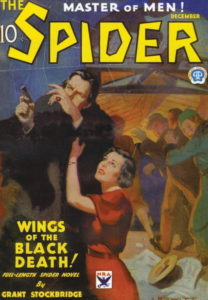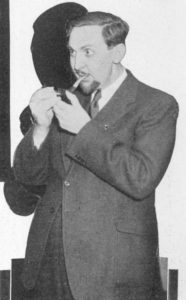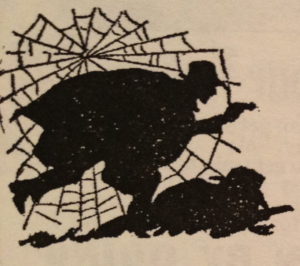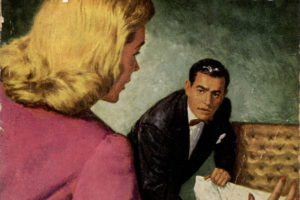
“Wings of the Black Death” was originally published in the December 1933 issue of The Spider magazine. Man-spread Black Plague ravages the city, and the public believes The Spider is to blame. But Richard Wentworth, never more sane, was gambling life itself in one desperate effort to save the city which cursed his name.
If you take all 118 Spider stories as a whole, this entry in the series is definitely above average. That’s not to say that it’s the best, or even among the best. But it is very good. The pulp magazine series had been started two issue earlier under the authorship of R.T.M. Scott. This third issue was the first written by Norvell W. Page, and was the first to carry the house byline of Grant Stockbridge.
As Page got more familiar with the character of The Spider, the plots would get more extreme. This, his first, is a bit more subdued. The story involves the bubonic plague, and can get a bit gory at times when the poor victims expire, blood gushing from their mouths. And, yes, that’s considered subdued by that standard set by some of the later stories. The tale packs plenty of action and a fair share of gory deaths. It is definitely a worthwhile read.

As our story opens, Wentworth is in the back of his limousine with Ram Singh at the wheel. He fingers a button under the left side of the seat. The entire section — cushioned back, seat and all — swing forward. The back revolves and a neatly hung rack of clothes is disclosed by a small shielded light. Wentworth dons his Spider outfit and prepares for his latest adventure.
The Spider has detected the first rumblings of crime. He senses the first outcreeping tentacles of crime. No one else notices anything strange. No one but… The Spider. Several small instances have caught his attention. Virginia Doeg has been arrested for substituting forged bonds for genuine ones in the office of MacDonald Pugh, a Wall Street broker. She claims to be innocent.
There was another small story in the papers: A dog had died from the Black Death… the bubonic plague! And that dog had belonged to Virginia Doeg, the girl accused of forgery. Individually, the two items meant nothing. Together, they indicated something sinister was approaching.
So in chapter one, The Spider is heading for John Harper‘s pawn shop. He knows the man to be a crook and fence. Somehow (and we’re never told exactly how) The Spider knows that Harper has the original bonds… the ones which he used to make the forgeries. So Wentworth gives Ram Singh instructions to call the police and tell them some stolen jewels will be found at the pawn broker’s. He figures he will be in and out by the time the police arrive to find Harper all tied up with the evidence before him… courtesy of The Spider.
Well, things don’t go exactly as planned. But that’s typical of a Spider tale, isn’t it? Yes, he catches the pawn broker upstairs in his apartment with stolen jewels strewn out on a black-velvet draped table. But Harper pulls a gun and The Spider is forced to kill him. When he opens the safe, there is no sign of the stolen bonds. But he does find one unexpected thing… something ominous!
The Black Plague
He finds a glass vial labeled “Hopkins Solution.” He recognizes it (must be a medical student or something, because who else would?) as being the only efficient antitoxin for the bubonic plague, more commonly known as the Black Death. And beside that vial is a card with two names upon it: Virginia Doeg and Mrs. Henry Gainsborough, of Roslyn, Long Island.
He pockets the card, marks the forehead his victim with the seal of The Spider, and is about to make his escape when he is stopped by a tall, heavy man. The man is armed; his face is also covered with a black mask. This is our first encounter with the story’s chief baddie, a heartless mass murderer who likes to be called the Black Death. How original…

Anyway, the police arrive, Wentworth dashes out the light and makes his escape. But apparently more happens after he leaves. Seems the mystery man kills the policemen and stamps their foreheads with his own Spider seal. Now our hero finds himself framed for killing two policemen!
Police Commissioner Stanley Kirkpatrick claims to be a good friend of Richard Wentworth. But he is convinced Wentworth is The Spider, who Kirkpatrick has sworn to bring to justice. It’s a complicated love-hate relationship. Now he believes The Spider, and that probably means Wentworth, is a police killer. Wentworth swears to Kirkpatrick that he will help bring the police killer to justice. There’s a lot unspoken, here. Wentworth means, but can’t say, that he wants to bring the mystery man to justice, not The Spider. Kirkpatrick means, but can’t say, that he’s going to bring Wentworth himself to justice.
Anyway, the first victim of the Black Death turns out to be Mrs. Henry Gainsborough, of Roslyn, Long Island. She’s the lady whose name was on the card in the pawnbroker’s safe. Turns out she is a blackmail victim. Either pay up a million dollars or her children will die of the Black Death.
Wentworth knows that this is but the tip of the iceberg. Where one blackmail letter has been received, there must be hundreds more such letters. And if even one victim refused, the Black Death would be loosed upon the city. Hundreds… thousands could be killed!
It’s unclear whether Mrs. Gainsborough has paid or not. But it doesn’t matter, because the mad killer is going to release the Plague, no matter what. He telephones the woman while Wentworth visits her. He declares his intentions of releasing the Plague upon the house. And although police are called and great pains are taken to guard the house and its occupants, the bubonic plague does strike. How?
the Plague strikes
On a distant hillside, a mysterious figure watches though binoculars. He sees the two children come out with a police escort and play upon the lawn. He releases a small, bright-eyed terrier which runs down to play with the children. He laughs an evil taunt.
Wentworth runs up, shoots the dog, and hustles the children inside. He snaps directions to Mrs. Gainsborough to call the doctor and bring Hopkins Solution with him. The antitoxin. The Black Death strikes with fearful swiftness. Within half an hour, the children’s faces have become gaunt and yellow with the fearful touch of the Plague. This is a new strain of plague that infects with an amazing speed. The children die, blood gushing from their mouths in ghastly pain. It’s a new reign of terror as the Black Death races through New York. Doctors find their antitoxins are worthless against it.
Who can stop this mad killer? Why, The Spider, of course. But things aren’t made easy for him. No, siree! The police are after him; three more policemen have been killed, all marked with The Spider’s red seal on their foreheads. The public at large feels he is the man behind the Plague, and they’re out for him, as well. There is no safe haven for our hero.
So what obstacles must our staunch hero overcome? Well, he’s unmasked by the fiend who calls himself the Black Death. The villain knows Wentworth is The Spider. He is framed by secretly replacing his cigarette lighter with another one. It’s the cigarette lighter, you may remember, that contains a secret compartment with The Spider seals. This replacement is designed so that the secret is easily revealed to the police. Not good for our hero!
But there’s much more. He’s trapped in a burning building. More people die from the Black Death, ramping up the pressure on The Spider. His last hope for a clue, Virginia Doeg, the girl with the dead dog, is kidnapped. Wentworth himself is taken prisoner, and Nita van Sloan must ransom him with all the money in his safe. Who other than Richard Wentworth would keep a quarter million dollars in cash in his safe. I mean, how much do you have in your safe? What’s that you say… you don’t even have a safe?
But our valiant hero never gives up. He tracks down even the slimmest of clues, and they produce results. Talk about luck! He tracks down the missing girl through the cigarettes she smokes. Not too realistic, considering the size of the city. But for The Spider, it works. Ah, the suspension of disbelief necessary to read pulps.
Pretty soon, the newspapers figure out that this whole plague thing is a gigantic blackmailer’s plot. And finally, the man known as the Black Death makes his demands known. The city must gather one billion dollars in random. Yes, billion with a “b.” The fiend will kill a hundred or so people today, just as a demonstration of his power. Then, if the city doesn’t come through, he will doom the entire metropolis.
How will he accomplish this? Well, it’s a secret to all but we readers. And eventually, Wentworth figures it out as well. It’s pigeons. Infected pigeons will be released, and will carry the bubonic plague everywhere. And now you understand the title of the story, “The Wings of the Black Death.” It all makes sense, now.
Chaos ensues
New York is in chaos. Already, ambulances race through the streets to the Lower East Side, where the Black Death has struck down people in the streets. The city is in panic. Thousands fled; trains and roads were jammed; it is like a war-time evacuation.
When the Commissioner Kirkpatrick discovers the secret compartment in Wentworth’s cigarette lighter (the duplicate lighter with the easily discovered compartment) he arrests Wentworth as The Spider. The compartment is empty; it contains no Spider seals. It’s never explained why. But apparently it’s still enough for the police to arrest our hero.

So the entire city is in peril, and Wentworth is in the custody of the police. Things can’t look much grimmer than that! How will The Spider ever save the day? Well, with the help of Nita van Sloan, of course. I won’t spoil the rest of it for you, but let’s just say it makes for a thrilling conclusion.
It’s pretty obvious from early on who the mastermind behind the Black Plague plot is. As is typical of pulp stories of this style, the unknown mastermind must be a new character, not a continuing one… must be someone beyond reproach — be the last person you would expect. It should be someone who apparently has no motive. It should be someone who apparently supports and believes in our hero, and then in the end will turn out to be working at cross purposes. There’s really only one such character in this story, so it doesn’t really take a great deal of thought to determine who the Plague Master will turn out to be. And sure enough, we’re right.
There’s no Jackson in this story. Jackson was mentioned once in issue #2, “The Wheel of Death,” as being his chauffeur. He was mentioned twice in #7, “Serpent of Destruction.” Once in #8. It’s #9, “Satan’s Death Blast,” before he actually takes part in one of the stories.
Ram Singh appears early on, but then disappears due to an injury. But he reappears at the end. Wentworth takes him to a doctor, who isn’t mentioned by name, but it is indicated that in the past, Wentworth had performed a very secret service for the man, and now the doctor would help him and ignore the requirement of reporting to the police the nature of the suspicious injuries. Although not named, I’m guessing this is Dr. Higgens, a recurring character in The Spider stories.
In many of The Spider magazine covers, The Spider is shown either with a domino mask or a disguised face, complete with fangs. But the story we read here described the mask as black silk that fits tightly across the eyes, then hangs limply down from there, concealing all of his face. There is no mention of any facial disguise… or fangs.
This was Norvell Page’s first entry into The Spider series. He took over from R.T.M. Scott, who had written the first two entries under his own name. Now the series had switched to Norvell Page and the house name of Grant Stockbridge was used.
Since it’s early in the series, there are some things that aren’t completely fleshed out yet. Wentworth does not own the entire building, it would seem, as in later stories. He just has a 15-room penthouse atop one of Fifth Avenue’s most fashionable buildings.
The Spider’s tools
Also mentioned here is that Wentworth carries a cigarette case that contains tear gas. He uses it in this story by throwing it to the floor and crushing it beneath his heel. Its intent, however, is to be used close to a man’s face.
The Spider also carried a length of silken cord upon him for emergencies. It’s referred to by a newspaper reporter refers as a “piece of the spider’s web.”
Another point of interest is The Spider’s shoes. We are told that went he goes forth to battle the Underworld, he switches to special high-topped shoes, light as a fencer’s but with thick, soft rubber soles. All the better to Spider around with…
And, in Wentworth’s toolkit, he carries a small vial made of wax. It contains hydrofluoric acid that will eat through glass. Seems like kind of a dangerous thing to be carrying around on your person, especially since it’s so soft and malleable. But no one ever accused The Spider of playing it safe.
This is a fun story from the early years of The Spider. It’s a rousing good romp with our pulp hero, The Spider!



Great write-up, John! ‘Going to get my hands on some of these Spider Pulps. Looks perfect for a Shadow fan!
They are similar enough that they will resonate with any Shadow fan. But they are different enough that you won’t feel you are reading a re-tread. And expect a ton more frantic action. They may be a little short on plot logic, but things move so fast that you rarely notice it. Let me know which one you read first.